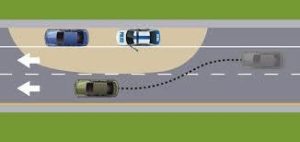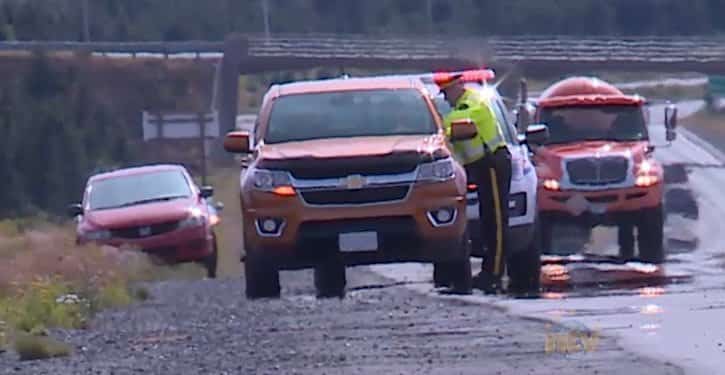Be Safe. Move Over. It’s the Law.
You’re driving down a multi-lane highway and you see a car pulled off to the side of the road. You notice that there is a police officer speaking with the driver. Or there is a vehicle or tow truck operator helping someone with a flat. Or a firefighter and paramedic tending to an accident.
It’s a common occurrence. We see this every day. But do you know how to handle the situation as a driver?
Far too often what you will also notice is how the other drivers are speeding by these vehicles within inches of those first responders. There are many stories of these people having to jump out of the way of an approaching vehicle speeding along at 100+ kms per hour. This is a far too common occurrence that these folks face each day while out doing their job and helping in the community.
When approaching any of these vehicles stopped by the side of the roadway, slow down or stop, and where possible, move over into a different lane if it is safe to do so. The general rule is to create a buffer lane by slowing down and putting as much distance as possible between you and the emergency vehicle. Not only is it the smart and safe choice, but the law requires drivers to do so throughout Atlantic Canada.
To help protect these people, legislation is in place. It is commonly known as the “Move Over” Law and is designed to protect those who drive emergency and other designated vehicles. It requires drivers to slow down and move over when approaching a designated vehicle that is stopped in a lane or on the shoulder of a roadway. By slowing down and moving over, motorists will increase the safety of those workers as they perform their duties and reduce their risk of being struck by an approaching vehicle.
The “Move Over” law applies when a designated vehicle is stopped and operating its red, blue or amber lights or has other traffic warning signals displayed. These designated vehicles include:
- police
- fire
- ambulance
- search and rescue
- tow truck/roadside assistance
- municipal, provincial or federal enforcement
- public utility vehicles and maintenance vehicles/ or
- service vehicles
The consequences vary by province, but in all cases, not following these laws will result in changes in demerit points and fines. Here is a summary of the laws in each province:
- Newfoundland & Labrador: Upon approaching an emergency vehicle, including a tow truck, that is stopped on a highway with its emergency lights on, drivers must slow down and proceed with caution, and move to another lane if it is safe to do so. (Highway Traffic Act 121.1)
- Nova Scotia: Drivers passing an emergency vehicle with flashing lights must slow down to 60 km/h or follow the posted speed limit (whichever is less) and must vacate the lane closest to the stopped vehicle, if it’s safe to do so. (Motor Vehicle Act 106E)
- New Brunswick: Drivers approaching a stopped emergency vehicle with at least one flashing light, must slow down, proceed with caution and move to a non-adjacent lane, if possible. (Motor Vehicle Act 168.1)
- Prince Edward Island: Drivers passing a stopped vehicle with flashing lights must decrease their speed to at least half the posted speed limit and must vacate the lane closest to the stopped vehicle, if it’s safe to do so. (Highway Traffic Act 115.1)
While the ‘Move Over’ law has been in place in some provinces since 2010, there are still drivers that are failing to slow down and move over. If you don’t slow down and move over when approaching a stopped emergency vehicle or law enforcement officer, it could result in property damage, serious injury or death. We are joining First Responders everywhere asking motorists to slow down, obey the laws and help keep these people safe.

If you would like more information on the Move Over legislation in your province, or if you have any questions on how to stay safe on our highways, please contact Munn Insurance at 855-726-8627 today. We are an Insurance company that offers free car insurance quotes and auto insurance quotes. With several coverage options, we have the right insurance plan for you!
Related News
Recent News
Decoding Commercial Insurance: 20 Essential Terms for Small to Medium-Sized Business Owners
Navigating the world of commercial insurance can be overwhelming, but understanding key terms is crucial for safeguarding your small to medium-sized business. Here are 20 essential terms explained in plain language: General Liability: Coverage protecting [...]
Top 10 Questions to Ask Your Broker Before Buying Insurance for Your Small Business
When purchasing insurance for your small business, it's crucial to ask your insurance broker the right questions to ensure you make informed decisions. Here are the top 10 questions to ask: 1. What Types of [...]
Knowing When to Switch: Finding the Right Insurance Broker for Your Property Portfolio
As a large business engaged in the construction, ownership, and management of numerous commercial properties and apartment buildings, ensuring robust insurance coverage is paramount. However, there may come a time when it's prudent to reassess [...]











